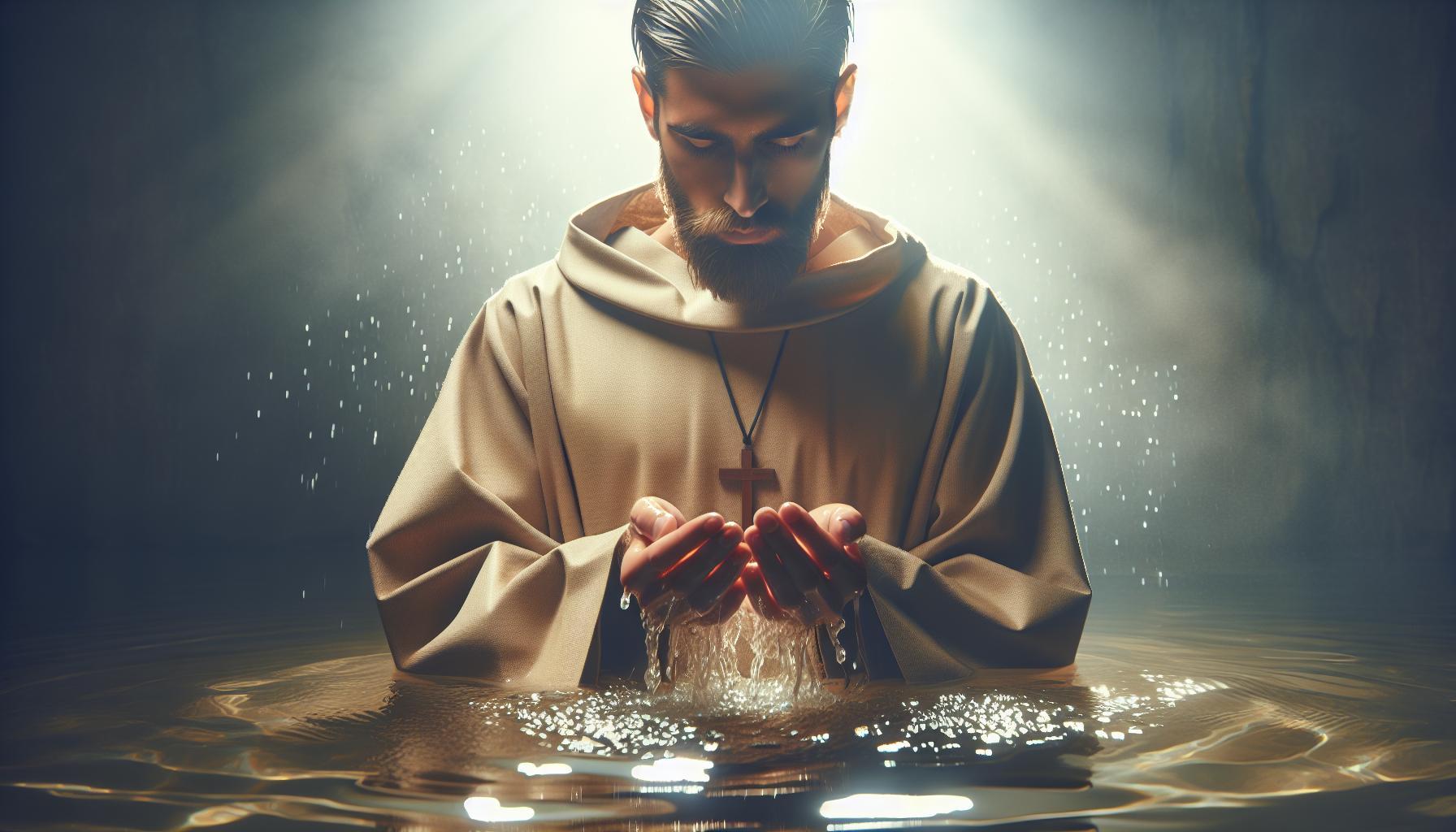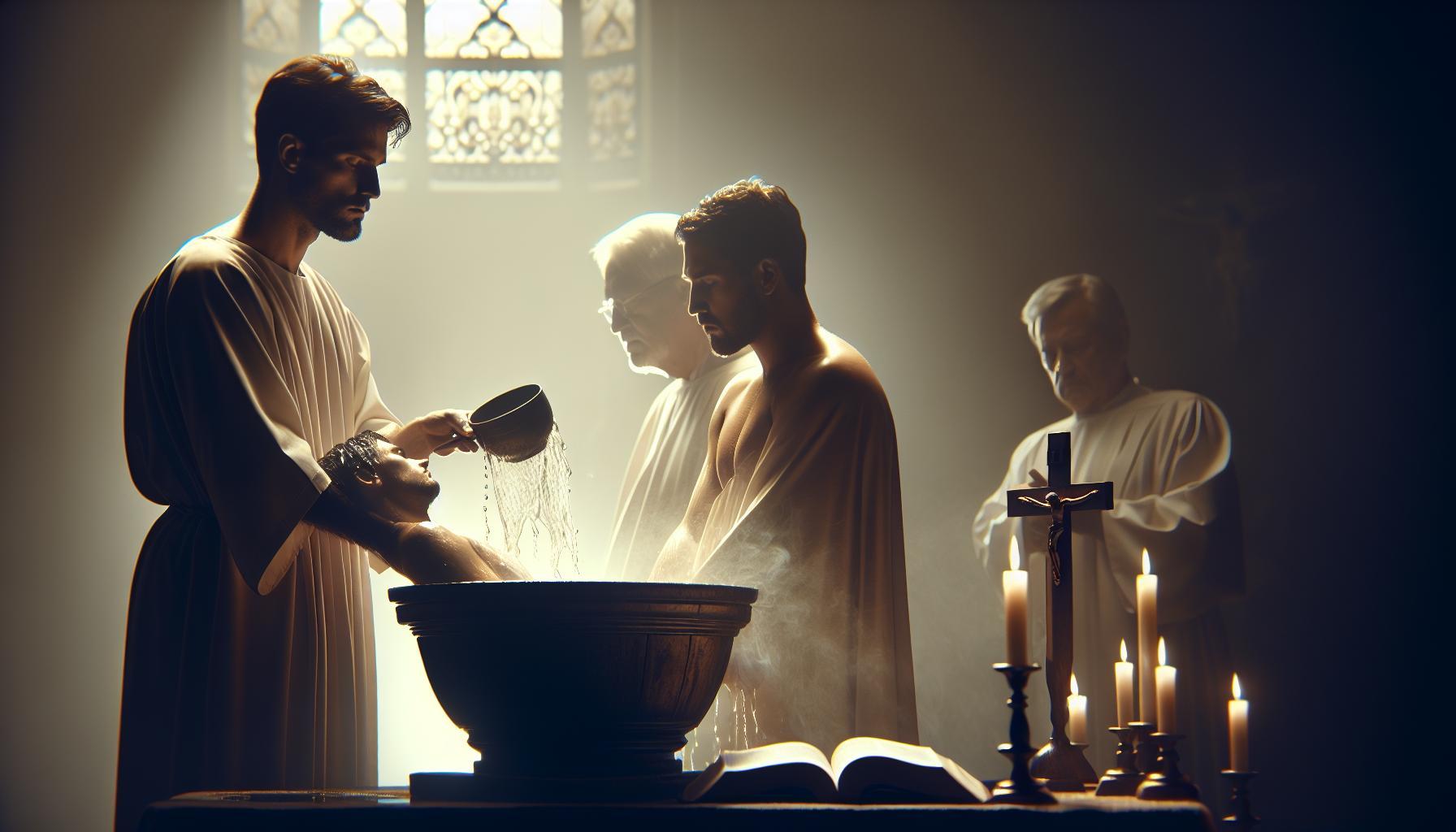Planning a baptism can feel overwhelming—what essentials do you need to ensure a smooth and memorable ceremony? This comprehensive checklist breaks down everything from spiritual preparations to practical items, making it easier to create a meaningful experience for your loved ones. Dive in to make your child’s baptism truly special!
Understanding the Significance of Baptism
Baptism is often described as one of the most profound expressions of faith in the Christian tradition. It symbolizes not only a person’s entrance into the Christian community but also an opportunity for spiritual renewal and commitment. is crucial for anyone planning to participate in this sacred ceremony. Whether you are preparing to welcome a child into the faith or planning your own baptism, grasping the depths of what this ritual entails will enhance its meaningfulness.
The Core Meaning of Baptism
At its core, baptism represents purification and a fresh start. Traditionally, it involves water—an element rich in symbolism, representing cleansing and rebirth. In many Christian denominations, this sacrament is associated with the teachings of Jesus Christ, who was baptized himself as a demonstration of obedience and humility. For individuals undergoing baptism, it marks a commitment to follow Christ’s teachings and a public declaration of their faith.
- Spiritual Renewal: Baptism signifies being born anew spiritually, shedding the burdens of the past.
- Community Involvement: Participating in baptism connects individuals to a wider faith community, providing support and encouragement.
- Divine Acceptance: It serves as an affirmation of God’s grace and acceptance, reinforcing the individual’s relationship with the divine.
Different Types of Baptism
While the essence of baptism remains consistent across various denominations, the practice and its connotations may differ. Some key types include:
| Type of Baptism | Description |
|---|---|
| Infant Baptism | Common in many Christian faiths, this baptism is performed shortly after birth, emphasizing God’s grace bestowed upon the child. |
| Believer’s Baptism | This practice involves individuals who are old enough to understand their faith, publicly declaring their commitment to follow Christ. |
| Spirit Baptism | Focuses on the Holy Spirit’s role in empowering believers, often accompanying the initial act of water baptism. |
Through these diverse expressions, baptism retains its foundational importance in the Christian journey. Whether it’s child or adult baptism, the emotional and spiritual impact of this ceremony provides participants with a critical milestone in their faith. Recognizing these dimensions as you approach your own baptism or that of a loved one can foster deeper connections and fulfillment during this sacred rite.
Essential Preparations: The Role of Parents and Godparents
The arrival of a new life is a joyous occasion, and with it comes the sacred tradition of baptism—a significant rite of passage for many families. This moment not only celebrates the child’s entry into a faith community but also underscores the vital roles parents and godparents play in the spiritual and moral upbringing of the child. Their preparations are crucial in ensuring that the ceremony is memorable and meaningful.
The Responsibilities of Parents
As the primary guardians, parents are tasked with several important duties leading up to the baptism. Firstly, they should choose a date and venue that resonates with their family’s spiritual beliefs and traditions. This might involve selecting a particular church that holds significant meaning or is frequented by the family. Consideration of guest availability is also paramount; it’s essential to ensure close family and friends can attend this beautiful occasion.
Next, parents will need to decide on the specifics of the ceremony, including any readings, prayers, or hymns they wish to incorporate. They may wish to consult with the officiating clergy or church representatives for guidance. Creating a list of potential reading materials and songs can help in this decision-making process. Additionally, parents should prepare for the post-baptism celebration, whether it’s a simple gathering or a larger reception, by organizing catering, decorations, and invitations.
The Role of Godparents
The selection of godparents is perhaps one of the most meaningful responsibilities in this process. Godparents serve not only as spiritual mentors but also as active participants in the child’s life, committed to supporting the parents in raising the child within the faith. When choosing godparents, consider individuals who embody the values you wish to impart to your child.
Once chosen, communicating with the godparents about expectations and roles is essential. They may need to attend pre-baptism classes, depending on the religious requirements of the church. This preparation ensures that they fully understand their responsibilities and the significance of the baptism ceremony.
- Support: Be there for the parents throughout the planning process.
- Gift: Consider presenting a meaningful gift to the child, symbolizing their spiritual journey.
- Participation: Be prepared to take an active role during the ceremony, such as holding the child during the baptism.
In summary, parents and godparents both have indispensable roles in preparing for a baptism. Their active participation not only supports the planning process but also enriches the ceremony, creating a nurturing environment centered on faith, love, and community. The collaboration between them sets the foundation for the child’s spiritual growth and connection to their heritage.
Choosing the Right Venue: Churches and Alternative Locations
When it comes to planning a baptism, the choice of venue is paramount in creating the perfect atmosphere for this sacred celebration. The right setting not only elevates the spiritual significance of the ceremony but also accommodates family and friends who gather to witness the occasion. While traditional churches are the go-to locations for many, there are also a variety of alternative settings that can add a unique touch to the baptism experience.
Traditional Church Venues
Opting for a church offers a time-honored approach to baptism, steeped in tradition and reverence. Many congregations provide dedicated spaces for baptisms, often designed to enhance the ceremony’s spiritual elements. Here are some benefits of choosing a church as your venue:
- Sanctified Environment: A church provides a serene ambiance that fosters reflection and spiritual growth.
- Community Involvement: Holding the baptism in your local church can help involve your community and faith group
- Professional Support: Many churches have staff and volunteers experienced in managing baptism ceremonies, ensuring that everything runs smoothly.
When selecting a church, consider factors such as the size of the congregation, accessibility for guests, and any specific requirements for the baptism ceremony itself.
Alternative Locations for Baptism
If you’re seeking a more personal or unique venue to celebrate this important milestone, alternative locations can provide a refreshing change of scenery. Here are some creative ideas that can transform your baptism into a memorable event:
- Backyard Gardens: Hosting the ceremony at home allows for an intimate setting surrounded by nature. A backyard or garden can be beautifully adorned with flowers and decorations, making it special.
- Community Parks: A local park offers ample space for families and friends to gather while enjoying the outdoors. This is ideal for larger groups, plus it encourages a laid-back atmosphere.
- Beaches or Lakes: For those near water, consider the natural beauty of a beach or lake. This setting can create a stunning backdrop for the baptism, symbolizing purification and the cycle of life.
- Rented Event Spaces: Renting a banquet hall or event center allows for planning a larger event without the restrictions that some venues have. You can customize the decor and layout to fit your vision.
When choosing an alternative venue, consider the amenities available, such as restrooms, seating, and parking. Additionally, it’s essential to check if there are any permits or insurance requirements necessary for your chosen location.
Factors to Consider
Regardless of whether you choose a church or an alternative venue for the baptism, several key factors should guide your decision-making process:
| Factor | Considerations |
|---|---|
| Capacity | Ensure the venue can comfortably accommodate all your guests. |
| Accessibility | Consider whether the location is easy for elderly or disabled guests to access. |
| Cost | Budget for any venue rental fees and additional expenses that may arise. |
| Aesthetics | Choose a location that resonates with your vision and enhances the ceremony’s theme. |
| Availability | Confirm that your desired date and time are available for booking. |
By carefully considering these factors and selecting the right venue, you can create a truly memorable baptism that aligns with your vision and meets all the essential needs for a perfect ceremony. The setting you choose can significantly enhance the experience, making it a day filled with love, joy, and cherished memories for you and your family.
The Ceremony: Exploring Different Baptism Traditions
Baptism is a cherished ritual in many cultures and religions, serving as a significant milestone in an individual’s spiritual journey. The ceremony symbolically represents purification and the acceptance of faith, often marked by various traditions that vary widely across different communities. Understanding these customs can help you tailor the perfect ceremony, ensuring it is as meaningful as it is memorable.
Christian Traditions
In Christian communities, baptism is often perceived as a sacramental rite that transcends denominations. Infant baptisms, prevalent in Catholicism and many Orthodox branches, typically involve the use of holy water and the anointing with oil to signify the child’s initiation into the faith. On the other hand, believer’s baptisms, endorsed by Protestants, usually take place upon a person’s declaration of faith, commonly performed in a body of water. Many Christians incorporate the following elements into their baptism ceremonies:
- Scripture Readings: Selected passages from the Bible that emphasize the significance of baptism.
- Godparents: Spiritual mentors who vow to guide the baptized in their faith journey.
- Public Confession: A personal proclamation of faith made during the ceremony.
Cultural Variations
Beyond the Christian context, various cultures have unique baptismal traditions that reflect their beliefs and heritage. For instance, in many African cultures, baptism rituals often involve elaborate celebrations with dancing, singing, and communal feasting to honor the occasion. In Hinduism, while not a baptism in the traditional sense, a Namkaran or naming ceremony parallels the themes of identity and spiritual initiation, where a child’s name is chosen in a sacred ceremony. Here are some notable practices:
- Water Symbolism: In many cultures, water is revered as a source of life and purification; whether through immersion, sprinkling, or anointing, its importance is universally recognized.
- Community Involvement: Celebrations often extend beyond the immediate family, inviting the wider community to witness and partake in the event.
- Gifts and Tokens: Traditional gifts may be given to symbolize blessings and well-wishes for the person being baptized.
Planning Considerations
When contemplating the elements needed for a baptism ceremony, it’s essential to think from both a ceremonial and practical standpoint. Here’s a helpful overview to guide your preparations:
| Aspect | Details |
|---|---|
| Venue | Choose a location that holds meaning, such as a church, home, or natural setting. |
| Attire | Traditional baptismal outfits can be special garments or simple white linen to signify purity. |
| Photography | Hire a professional or designate a family member to capture the special moments. |
| Reception | Plan a gathering post-ceremony to celebrate with friends and family, including food and entertainment. |
By delving into the rich diversity of baptismal traditions, you can create a ceremony that reflects your beliefs while honoring the customs of those who mean the most to you. Whether you’re compiling your list of elements based on “What Do You Need for a Baptism? Complete Checklist for a Perfect Ceremony” or simply seeking inspiration, these insights will help you craft a celebration infused with meaning and joy.
Arranging the Details: Invitations, Guests, and Photography
Inviting loved ones to a baptism is a heartfelt way to share this significant moment in your child’s spiritual journey. The right invitation can set the tone for the celebration and ensures your guests have all the necessary details. With so many options available for baptism invitations, you can easily create a custom design that reflects your child’s personality and the ceremony’s spirit. Consider using platforms like Canva for free, customizable templates that you can print from home or order professionally printed invitations from services like Vistaprint or Simply to Impress.
Guest List Planning
When arranging your guest list, it’s helpful to start by considering both close family and friends who play an important role in your child’s life. A baptism is not only a religious ceremony but also a family gathering, and it’s a wonderful opportunity to introduce your child to those who will be part of their spiritual upbringing. Here are some tips for creating your guest list:
- Immediate Family: Think about parents, grandparents, and siblings.
- Extended Family: Aunts, uncles, cousins, and significant family friends.
- Family Friends: Close friends of the family who are likely to have an ongoing role in your child’s life.
To keep track of your invitations and RSVPs, consider using a simple table format, as shown below:
| Name | Address | RSVP Status |
|---|---|---|
| Emma Johnson | 123 Maple St, Springfield | Accepted |
| John Smith | 456 Oak St, Springfield | Pends |
| Linda Brown | 789 Pine St, Springfield | Declined |
Capturing the Moment
Photography is essential for preserving the memories of your child’s baptism. Whether you hire a professional or enlist a family member with a talent for photography, make sure to capture key moments such as the ceremony, family portraits, and candid shots of guests. Here are a few tips to ensure everything is photographed beautifully:
- Make a Shot List: Create a list of must-have shots so no moment is overlooked.
- Discuss Expectations: Communicate with your photographer about important details like the timeline of the ceremony.
- Consider a Backup: If feasible, arrange for a second photographer to cover different angles and scenes.
In summary, planning your baptism invites, guest list, and photography requires attention to detail but can also bring joy as you prepare for this major event. By utilizing available resources and technology, you can ensure that every aspect of this special day is carefully arranged, allowing you to focus on what matters most: celebrating your child’s first steps in faith.
Selecting Baptismal Attire: What to Wear and Why It Matters
Choosing the right attire for a baptism is not just about aesthetics; it reflects the significance of the sacred event. Whether you’re the parent, godparent, or a guest, what you wear conveys respect for the occasion and helps create an environment of reverence and joy. This attire often intertwines tradition with personal significance, making it a crucial part of the baptismal ceremony.
Considerations for Parents and Godparents
For parents and godparents, the choice of clothing can be particularly poignant. Many opt for traditional outfits, such as a white dress for the baby, symbolizing purity and new beginnings. But for adults, the choice often balances elegance with comfort. Here are a few recommendations:
- Material: Choose breathable fabrics, especially if the ceremony takes place in warm weather.
- Color: While white is a popular choice for the child, adults may choose pastel colors or even soft earth tones that signify calm and peace.
- Fit: Ensure that the attire allows for easy movement—ceremonies can often involve carrying or holding the child.
What Guests Should Wear
Guests attending a baptism should also consider their attire to align with the event’s formality. Depending on the baptism’s setting—whether in a church or outdoors—your outfit can reflect the ambiance while still showing appropriate respect.
- Formal Attire: For a church ceremony, consider wearing a nice dress or a suit. Avoid overly casual clothing like jeans and t-shirts.
- Footwear: Choose shoes that are comfortable yet polished. If you’re attending a baptism outdoors, consider how your shoes will fare on grass or uneven surfaces.
- Accessories: Keep accessories subtle but meaningful, perhaps incorporating something that reflects the child’s family heritage.
Creating Lasting Memories Through Attire
The baptism is a momentous occasion, and attire plays a role in creating lasting memories. Many families choose to have matching outfits for siblings or coordinate colors, which can enhance the visual beauty of the event. A well-thought-out outfit can also serve as a cherished keepsake. For instance, many parents save their child’s baptism gown to pass down as a family heirloom.
This attention to detail in selecting baptism attire not only highlights the importance of the ceremony but also contributes to an overall sense of community and belonging. By considering your outfit thoughtfully, you ensure that the baptism is not just a personal memory but a collective celebration of faith and family.
Spiritual Readiness: Engaging with Your Faith Community
Engaging with your faith community is not just an optional step in the baptism process; it’s a vital part of preparing for this significant spiritual milestone. Participating in community traditions and gatherings can enrich your baptism experience, connecting you more deeply with your faith and those who share it. Cultivating these relationships and engaging in communal practices provides a foundation that can enhance your spiritual journey.
Building Connections Within the Community
Before the ceremony, consider reaching out to members of your faith community. This is a wonderful opportunity to strengthen bonds and garner support as you prepare for baptism. Here are some ways to become more engaged:
- Attend Worship Services: Regular participation in services can help familiarize you with important rituals and unite you with fellow congregation members.
- Join a Class: Participating in baptism classes or preparation sessions allows you to learn more about the significance of baptism while forming connections with others who share similar spiritual paths.
- Volunteer: Getting involved in community service or ministry groups can create a sense of belonging and involvement in your faith community.
- Share Your Journey: Don’t hesitate to share your baptism story and intentions with others. These conversations can deepen your understanding and commitment.
Understanding Community Traditions
These communal practices vary between denominations and may also include specific traditions unique to your local faith community. Familiarize yourself with rituals that could enhance your baptism experience. For instance, some communities hold special fellowship gatherings before the baptism, while others may include a group prayer as part of the ceremony. Engaging in these communal customs not only provides support but also reinforces the communal nature of faith.
Creating a Supportive Network
As you prepare your checklist for the ceremony, consider compiling a list of friends, family, and mentors within your community who can act as your support system. You might want to include:
| Name | Relationship | Role During Baptism |
|---|---|---|
| John Smith | Uncle | Sponsor |
| Mary Johnson | Best Friend | Reader |
| Pastor Emily | Spiritual Mentor | Officiant |
This network can provide both emotional and practical support, ensuring you feel connected on the day of your baptism. Remember, your involvement in the faith community is not just about the ceremony; it’s about embracing a lifelong journey of faith, surrounded by those who uplift and inspire you.
After the Ceremony: Celebrating and Living Out the Commitment
The moment of baptism marks not only a spiritual milestone but also the beginning of a beautiful journey dedicated to faith and community. This special occasion calls for a celebration that goes beyond the ceremony itself, allowing families and friends to come together in joy and gratitude. After the baptism, it’s essential to create meaningful memories and reinforce the commitments made during the ceremony. This is a time to celebrate with loved ones, reflecting on the significance of the event and the responsibilities it entails.
Celebrating the Baptism
Consider hosting a baptism reception that brings together family and friends to celebrate the new beginnings symbolized by the ceremony. This gathering can take many forms, from a simple family meal to a larger party, depending on your preferences and resources. Here are some popular ideas for making the celebration special:
- Food and Drinks: Prepare a menu that includes the favorite dishes of the honored guest, whether it’s a lavish buffet or a simple cake and refreshments.
- Theming: Incorporate elements that reflect the baptism’s significance, such as decorations in light blues and whites, symbolizing purity and new life.
- Activities: Plan activities or games that involve all ages, such as a memory-sharing session where guests can tell stories about the person baptized.
Living Out the Commitment
The commitments made during the baptism, especially in relation to nurturing faith, extend well beyond the ceremony. Families should regularly engage in activities that reinforce the promises made during this sacred event. Consider these practices to incorporate into daily life:
- Weekly Family Worship: Set aside time each week to read scripture, pray, and discuss faith matters as a family.
- Service Projects: Participate together in community service or church events that reflect the values of kindness and love that baptism represents.
- Annual Remembrances: Celebrate the anniversary of the baptism each year with a special activity, such as sharing a meal or revisiting the ceremony location.
By proactively engaging in both celebration and commitment, families can foster a nurturing environment that grows in faith and community. This holistic approach ensures that the essence of the baptism is honored not just on the day itself but becomes integrated into the life journey of the individual and their family.
Q&A
What do you need for a baptism?
To prepare for a baptism, you typically need a few essential items: a baptismal gown, baptismal candles, and possibly a certificate or keepsake. Each denomination may have additional requirements or traditions that could influence what you need for a memorable ceremony.
For example, many parents choose a beautiful baptismal gown for their child, which symbolizes purity and new beginnings. Additionally, lighting a baptismal candle may represent the light of Christ entering the baby’s life. Consider exploring denominational customs or guidelines to ensure you are fully prepared for this sacred event. You can also find more about baptism rituals here.
Can I personalize the baptism service?
Yes, personalizing a baptism service is encouraged and can enhance the meaning of the ceremony. Many families incorporate special readings, music, or symbols that reflect their faith and values, making the event unique.
For instance, you might select a specific scripture passage that holds personal significance, or choose hymns that resonate with your family. Personal touches can deepen the emotional impact of the day, allowing the community to witness your family’s commitment to raising the child in the faith.
Why does the baptism ceremony include godparents?
Godparents play a vital role in a baptism as spiritual mentors and supporters for the child. They are typically chosen by the parents to guide the child in faith and help nurture their spiritual growth.
The selection of godparents can vary, but it is often viewed as a significant commitment. They may need to be confirmed members of the faith tradition and are expected to provide support and guidance, ensuring the child embraces their spiritual journey. This emphasizes the communal aspect of faith, reinforcing the idea that raising a child in the church is a shared responsibility.
What is a baptism certificate and why is it important?
A baptism certificate is an official document that records the baptism’s details and serves as a significant milestone in the child’s spiritual life. It can be important for future religious milestones, such as confirmation or marriage.
This certificate often includes the child’s name, the date of baptism, and the officiant’s details. It’s not only a record for the church but can also be a cherished keepsake for the family. Documenting this important event helps emphasize its significance in the child’s spiritual heritage.
How do I prepare my child for baptism?
Preparing your child for baptism involves educating them about the significance of the ritual and its spiritual implications. Discussing the meaning of baptism, using age-appropriate language, can help them understand its importance in their faith journey.
You might also engage them in simple discussions about God and the community they will join. Incorporating stories, songs, or even inviting them to participate in the service can make the experience more relatable and meaningful. Preparation is not just about the ceremony but about fostering a lifelong understanding of their faith.
What role does the church play in a baptism?
The church serves as the spiritual home where baptisms are conducted and plays a key role in the entire baptism process. It provides guidance, pastoral care, and a community of faith supportive of the child’s spiritual growth.
Church leaders, such as priests or pastors, usually facilitate the baptism and offer spiritual direction before and after the event. The congregation also participates, welcoming the newly baptized into the community and affirming their role in supporting the child’s faith development. Thus, the church fosters an atmosphere of love and encouragement in this sacred commitment.
Can baptism be conducted at home?
Yes, many families choose to conduct baptisms at home, especially in situations where travel to a church is difficult. In such cases, it’s important to consult with your clergy for guidance and to ensure the ceremony remains meaningful.
A home baptism can include elements such as family members sharing readings, prayers, or songs that hold special significance to your faith. However, it’s essential to follow your denomination’s guidelines to maintain the ceremony’s integrity and purpose. Engaging your church community, even remotely, can still foster a connection to your faith.
Closing Remarks
As you prepare for the sacred occasion of a baptism, we hope this comprehensive checklist has illuminated the essential elements needed for a beautiful and meaningful ceremony. From understanding the theological significance behind the ritual to ensuring you have the practical items in place, each aspect plays a vital role in honoring this important step in one’s spiritual journey.
We encourage you to reflect on the richness of this tradition, whether you are a parent, godparent, or member of the community supporting someone on this path. Explore the diverse rituals, engage with your faith community, and consider how you can contribute to a joyous celebration of new life in faith.
Remember, every baptism is unique, and as you embark on this journey, you are not alone. Embrace the support of those around you and feel free to reach out for any questions or further guidance. May your experience be filled with love, hope, and a deep sense of connection to the sacred.





